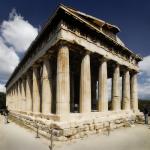|
This section contains 1,999 words (approx. 7 pages at 300 words per page) |

|
The Etruscan Influence.
Roman sculpture has its roots in Etruria, an ancient country north of Rome. According to tradition, the Etruscans were immigrants from Asia Minor who migrated to Italy, perhaps during the general meltdown at the end of the Bronze Age, in the years following 1200 B.C.E. Once they arrived, they established themselves as a ruling class that exploited the resources of one of the richest regions of Italy. Etruria was an important export market for Greek vases, and Greek artisans worked in its cities for Etruscan patrons. One such colony of Greek craftsmen existed in Caere (modern Cerveteri, north of Rome), where there is still a large Etruscan necropolis. The paintings in the Etruscan underground tombs at Tarquinia were probably done by Greek artisans, though the taste is Etruscan. Rome's last three kings were Etruscan; the last of them, Tarquin the Proud, who...
|
This section contains 1,999 words (approx. 7 pages at 300 words per page) |

|




